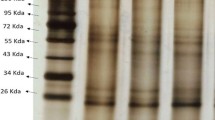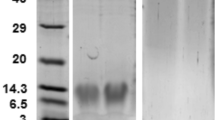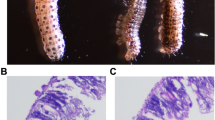Abstract
Rice swarming caterpillar, Spodoptera mauritia, is a major pest of paddy. Insect growth regulators are a class of substances that interfere with insects’ natural growth, development, and reproduction by disrupting physiological processes. Insect growth regulators are appropriate for pest management as they are more target-specific, non-persistent, biodegradable, and ecologically benign compounds with reduced toxicity to non-target organisms. In this study, we showed that treatment of 5th instar day 0 larvae of S. mauritia with the JH-mimic, pyriproxyfen, increases the level of an 83 kDa haemolymph protein band in SDS-PAGE compared to control. The pyriproxyfen–responsive protein was identified by mass spectrometry as arylphorin, a hexameric storage protein. It is revealed that in native state it is a high molecular weight multimeric protein. Also we showed that the increase in level of arylphorin on exposure to pyriproxyfen is the result of induction of protein synthesis. As storage proteins are crucial for insect development and metamorphosis and the level is altered by insecticides like pyriproxyfen, the role of arylphorin in the physiology of the larvae exposed to insecticides needs to be explored.





Similar content being viewed by others
References
Basiouny A, Ghoneim K (2018) Impairment of development and reproductivity of egyptian cotton leafworm Spodoptera littoralis Boisduval (Noctuidae: Lepidoptera) by cycloheximide (Acti-Dione). Egypt Acad J Biol Sci A Entomol 11(5):31–58
Burmester T, Massey HC, Zakharkin SO, Bense H (1998) The evolution of hexamerins and the phylogeny of insects. J Mol Biol 47:93–108. https://doi.org/10.1007/pl00006366
Burmester T (1999) Evolution and function of the insect hexamerins. Rev Eur J Entomol 96:213–225
Burmester T (2015) Expression and evolution of hexamerins from the tobacco hornworm, Manduca sexta, and other Lepidoptera. Insect Biochem Mol Biol 62:226–234. https://doi.org/10.1016/j.ibmb.2014.11.009
Chandrasekar R, Sumithira P, Seo SJ, Krishnan M (2008) Sequestration of storage protein 1 (SP1) in differentiated fat body tissues of the female groundnut pest Amsacta albistriga (Lepidoptera: Arctiidae). Int J Trop Insect Sci 28:78–87. https://doi.org/10.1017/S1742758408007728
De A, Bose R, Kumar A, Mozumdar S (2014) Worldwide pesticide use. Targeted delivery of pesticides using biodegradable polymeric nanoparticles. Springer, New Delhi, pp 5–6
Dutta S, Mohapatra J, Ghosh AK (2020) Molecular characterization of Antheraea mylitta arylphorin gene and its encoded protein. Arch Biochem Biophys, 108540. doi: https://doi.org/10.1016/j.abb.2020.108540
FAO, FAO study (2021) Climate change fans spread of pests and threatens plants and crops, new (2021, June 2) Food and Agriculture Organization of the United Nations. https://www.fao.org/news/story/en/item/1402920/icode/ Accessed 23 March 2022
FAOSTAT-pesticide use (2021) Food and Agriculture Organization of the United Nations. https://www.fao.org/faostat/en/#data/RP Accessed 27 March 2022
Fujii T, Sakurai H, Izumi S, Tomino S (1989) Structure of the gene for the arylphorin-type storage protein SP2 of Bombyx mori. J Biol Chem 264:11020–11025. https://doi.org/10.1016/S0021-9258(18)60421-1
Hahn DA, Wheeler DE (2003) Presence of a single abundant storage hexamerin in both larvae and adults of the grasshopper, Schistocerca americana. J Insect Physiol 49:1189–1197. https://doi.org/10.1016/j.jinsphys.2003.09.002
Haunerland NH (1996) Insect storage proteins: gene families and receptors. Insect Biochem Mol Biol 26(8–9):755–765. https://doi.org/10.1016/S0965-1748(96)00035-5
Hou Y, Li J, Li Y, Dong Z, Xia Q, Yuan YA (2014) Crystal structure of Bombyx mori arylphorins reveals a 3:3 heterohexamer with multiple papain cleavage sites. Protein Sci 23(6):735–746. https://doi.org/10.1002/pro.2457
Jones G, Brown N, Manczak M, Hiremath S, Kafatos FC (1990) Molecular cloning, regulation, and complete sequence of a hemocyanin-related, juvenile hormone-suppressible protein from insect hemolymph. J Biol Chem 265(15):8596–8602. https://doi.org/10.1016/S0021-9258(19)38929-X
Kanost MR, Kawooya JK, Law JH, Ryan RO, Van heusdan MC, Zeigler R (1990) Insect haemolymph proteins. Adv In Insect Phys 22:299–396
Laemalli UK (1970) Cleavage of structural proteins during assembly of the head bacteriophage T4. Nature 227:680–685. https://doi.org/10.1038/227680a0
Levenbook L (1985) Insect storage proteins. In: Gilbert LI, Kerkut G (eds) Comprehensive Insect Biochemistry, Physiology and Pharmacology, vol 10. Pergamon Press, Oxford, pp 307–346
Magee J, Kraynack N, Massey HC Jr, Telfer WH (1994) Properties and significance of a riboflavin-binding hexamerin in the hemolymph of Hyalophora cecropia. Arch Insect Biochem Physiol 25:137–157. https://doi.org/10.1002/arch.940250206
Miura K, Nakagawa M, Chinzei Y, Siiinoda T, Nagao E, Numata H (1994) Structural and functional studies on biliverdin-associated cyano protein from the bean bug, Riptortus clavatus. Zool Sci 11:537–545
Pan M, Telfer W (2001) Storage hexamer utilization in two lepidopterans: differences correlated with the timing of egg formation. J Insect Sci 1:1–9. https://doi.org/10.1673/031.001.0201
Peter MG, Scheller K (1991) Arylphorins and the integument. In: Retnakaran A, Binnington K (eds) The physiology of Insect Epidermis. CSIRO Publications, Melbourne, pp 115–124
Resmitha C, Kannan VM (2016) Toxicity of Insect Growth Regulator, Pyriproxyfen, on larvae of Spodoptera mauritia Boisd. (Lepidoptera: Noctuidae). Int J Agric Innov Res 5(1):173–176
Resmitha C, Kannan VM (2017) The juvenile hormone mimic, pyriproxyfen, increases the level of the major haemolymph protein in the larvae of Spodoptera mauritia Boisd. Lepidoptera: Noctuidae. Int J Entomol Res 2(6):11–15
Roberts DB (1987) In: Law JH (Ed.), Entomology M (eds) The function of the major larval serum protein of Drosophila melanogaster: a review. Alan R. Liss, New York, pp 285–294
Ryan RO, Keim PS, Wells MA, Law JH (1985) Purification and properties of a predominantly female-specific protein from the haemolymph of the larva of the tobacco hornworm, Manduca sexta. J Biol Chem 260:782–787. https://doi.org/10.1016/S0021-9258(20)71166-X
Sakunthala C (2009) Morphogenetic effects of insect growth regulators on Spodoptera mauritia Boisd. (Lepidoptera: Noctuidae). Dissertation, University of Calicut
Sakurai H, Fujii T, Izumi S, Tomino S (1988) Complete nucleotide sequence of gene for sex-specific storage protein from Bombyx mori. Nucleic Acid Res 16:7717–7718. https://doi.org/10.1093/nar/16.15.7717
Sarma AK, Damgaard C, Neog P (2021) Retrospection of Outbreaks of Spodoptera mauritia Boisduval in NER India: the solution lies in Ecological Engineering, not in insecticides. Sustainability 13:12824. https://doi.org/10.3390/su132212824
Shevchenko A, Tomas H, Havlis J, Olsen JV, Mann M (2007) In-gel digestion for mass spectrometric characterization of proteins and proteomes. Nat Protoc 1(6):2856–2860. https://doi.org/10.1038/nprot.2006.468
Sousa KKA, Camargo R, da Forti S, Caldato LC N (2018) Effects of cycloheximide on the mortality of Atta sexdens, leaf-cutting worker ants. Rev Bras Entomol 62(3):169–171. https://doi.org/10.1016/j.rbe.2018.04.002
Tang B, Wang S, Zhang F (2010) Two storage hexamerins from the beet armyworm Spodoptera exigua: Cloning, characterization and the effect of gene silencing on survival. BMC Mol Biol 11(1):65–77. https://doi.org/10.1186/1471-2199-11-65
Telfer WH, Massey HC (1987) A storage protein from Hyalophora that binds riboflavin and resembles the apoprotein of hemocyanin. In: Law JH (ed) Molecular Entomology. UCLA symposia on molecular and cellular biology (New Series). Alan R Liss Inc, New York, pp 305–314
Telfer WH, Kunkel JG (1991) The function and evolution of insect storage hexamers. Annu Rev Entomol 36:205–228. https://doi.org/10.1146/annurev.en.36.010191.001225
Tunaz H, Uygun N (2004) Insect growth regulators for insect pest control. Turk J Agric For 28:377–387
Tysell B, Butterworth FM (1978) Different rate of protein granule formation in the larval fat body of Drosophila melanogaster. J Insect Physiol 24:201–206. https://doi.org/10.1016/0022-1910(78)90035-5
Wang S, Hu B, Wei Q, Su J (2019) Cloning and characterization of hexamerin in Spodoptera exigua and the expression response to insecticide exposure. J Asia Pac Entomol 22:602–610. https://doi.org/10.1016/j.aspen.2019.04.006
Wang YC (2001) Insect biochemistry (in chinese). China Agriculture Press Beijing
Wheeler DE, Tuchinskaya I, Buck NA, Tabashnik BE (2000) Hexameric storage proteins during metamorphosis and egg production in the diamondback moth, Plutella xylostella (Lepidoptera). J Insect Physiol 46:951–958. https://doi.org/10.1016/S0022-1910(99)00202-4
Willott E, Wang XY, Wells MA (1989) cDNA and gene sequence of Manduca sexta arylphorin, an aromatic amino acid-rich larval serum protein. J Biol Chem 264(32):19052–19059. https://doi.org/10.1016/S0021-9258(19)47265-7
Worldatlas (2018) https://www.worldatlas.com/articles/top-pesticide-consuming-countries-of-the-world.html
Zheng Y, Yoshiga T, Tojo S (2000) cDNA cloning and deduced amino acid sequences of three storage proteins in the common cutworm, Spodoptera litura (Lepidoptera: Noctuidae). Appl Entomol Zool 35(1):31–39. https://doi.org/10.1303/aez.2000.31
Acknowledgements
University Grants Commission, New Delhi for financial support, UGC Special Assistance Programme (SAP), Department of Zoology and Centre for Advances in Molecular Biology (CAMB), University of Calicut for the facilities.
Funding
This work was supported by the University Grants Commission, New Delhi.
Author information
Authors and Affiliations
Corresponding author
Ethics declarations
Conflict of Interest
We declare that we do not have any conflict of interest.
Additional information
Publisher’s Note
Springer Nature remains neutral with regard to jurisdictional claims in published maps and institutional affiliations.
Rights and permissions
Springer Nature or its licensor (e.g. a society or other partner) holds exclusive rights to this article under a publishing agreement with the author(s) or other rightsholder(s); author self-archiving of the accepted manuscript version of this article is solely governed by the terms of such publishing agreement and applicable law.
About this article
Cite this article
C, R., Meethal, K.V. The level of arylphorin in the haemolymph of Spodoptera mauritia Boisd. (Lepidoptera: Noctuidae) larvae is increased by the insecticide, pyriproxyfen. Int J Trop Insect Sci 43, 655–664 (2023). https://doi.org/10.1007/s42690-023-00975-y
Received:
Accepted:
Published:
Issue Date:
DOI: https://doi.org/10.1007/s42690-023-00975-y




